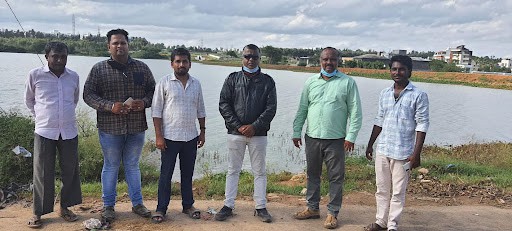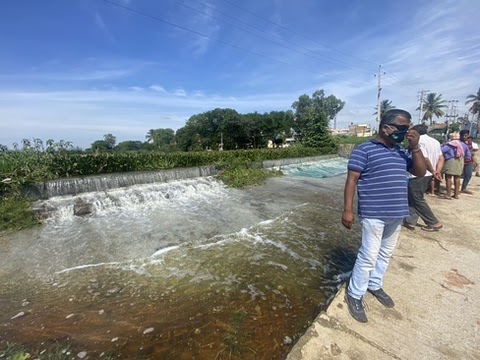“Lakes are like the organs and rajakaluve, or the storm water drains that connect them, are like nerves. Organs will not survive without the nerves,” says Captain Santhosh Kumar, an army veteran who has been volunteering towards identifying and restoring storm water drains and lakes of Bengaluru.
Read more: 50% stormwater drains lost: Bengaluru’s flooding is no surprise
It all started when Kumar, a military intelligence officer hung up his boots and returned to his native village Anekal in Bengaluru urban district, in 2008. He was shocked when he saw the villagers struggle for water while the water mafia pumped the lakes around, through illegal borewells, to supply water to the city. The untreated sewage and industrial effluents were polluting all those lakes in which he swam as a child. “I am a farmer’s son; I couldn’t bear this abuse of land and water” said Kumar. This encouraged him to divert his efforts towards saving and rejuvenating the lakes of Bengaluru.

While many of his complaints about illegal borewells to the city authorities, in 2018, went unheard, the army veteran decided to use his professional training to unearth and collect data and evidence of encroachments and misuse, to persuade the authorities. “I started with understanding what the root cause was for the lakes not filling up with water. It was not the case 25 years ago, when these lakes were filling up with the same amount of rain,” he explained, adding, “I realised then that most storm water drains were either encroached or silted over time.”
For almost a year, Santhosh Kumar surveyed the land on foot, referring to the maps from the Revenue Department dating back from 1923 to 1970. The British era maps had a clear demarcation of storm water drains. Kumar also utilised Google Earth maps to understand the elevations of various lakes. Once the storm water drains were identified, began the task of bringing city authorities on board, for removing illegal encroachments, desilting, widening and removing wild growth from these water channels and reservoirs.
The work first began on the 4.5 kilometres storm water drain between Muthanallur lake and Batalkere lake that had been encroached upon by farmers. An official survey by the Minor Irrigation Department, in the know of village panchayat and Deputy Commissioner of Bangalore Urban District, J. Manjunath, led to clearance of the encroachment.
The storm drain was cleared within a hundred days from March to June 2021. As Batalkere lake filled with rainwater, work began on another five kilometre stretch of storm drain between Gattahalli and Huskur lakes.
Read more: Can citizen groups maintain Bengaluru lakes? Legal tussle continues
Bengaluru’s history of storm water drains
Bengaluru, which is on a 900 m elevation, was once a small town of the expansive Chola kingdom. At the time, the Cholas had laid down a network of lakes and storm water drains to catch and store the rainwater across the kingdom. The system worked very efficiently on the principles of gravitational force with the storm water drains transporting water from a lake at higher altitude, as soon as it filled up, to the lake at lower altitude. The 857 lakes in the network prevented flooding, while maintaining water level in all lakes.
Over time, urbanisation in Bengaluru led to encroachments on storm water drains and lakes and with these drains blocked, rainwater flooded the city, while lakes filled up with silt and city waste.

The community movement
With city authorities lending logistic support to Santhosh Kumar’s campaign, some city dwellers and village residents are now also joining hands in locating and restoring the storm drains.
Mithilesh Kumar, an AI Development Manager, who has been staying in Bengaluru for the last few years said, “I noticed the changes in temperatures and water problems which were not there earlier. I came to know that drying up of lakes was the reason behind such weather changes. We decided to do our bit for the conservation of lakes.”
He formed a group ‘Citizen Movement’ consisting of like-minded people from different housing societies to participate in rejuvenation of the lakes under the guidance of Santhosh Kumar. The group has recently begun work on restoration of Halenayakanhalli and Choodasandara lakes. He added, “It is however a daunting task to get encroachments by builders removed from rajakaluve. We also are trying to connect with villagers on the outskirts of Bengaluru to involve them with upkeep of lakes. It is just a beginning and we have a lot to do.”
Gopal Chembe, who works in the legal department of an MNC, came to know about the restoration work done by Santhosh Kumar through social media. He along with Rangaraju and Muniraju and residents of four villages came together to seek help from Santhosh Kumar for the Chabenahalli and Valagere Kallahalli lakes in their vicinity. After the official survey by city authorities, the digging of lakes started.
The panchayat also issued special instructions against trash dumping in the cleaned lake that had filled up with water, owing to heavy rains in the past few months. “There was no water in Valgerekallahalli Lake since it was dry and encroached upon. Now some rainwater has collected in it after we cleared it. It is yet to be connected with storm drain,” said Shashikumar Reddy, one of the village residents.

The positive results have slowly garnered the much required attention of the city authorities and locals. The crusade to save the lakes of Bengaluru seems to be moving in a positive direction. The removal of all kinds of encroachments is gradually underway too.
“Awareness is the key,” said Kumar, as he prepared to check the status of a 15 kilometre stretch of storm water drain. “The more people understand the benefits of keeping lake systems healthy and the repercussions of misuse, half our water problems will be solved.”
[This story was first published on Mongabay India and has been republished with permission. The original article can be read here.]